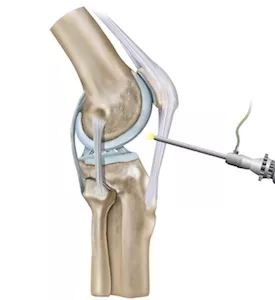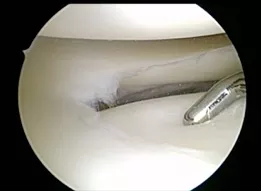Keyhole knee surgery
If you have got a pain in the knee after an injury, or coming on out of the blue, or you have been told by someone that you have a cartilage tear then you may well need a knee arthroscopy (keyhole surgery).
Knee arthroscopy surgery
Knee arthroscopy is used to treat problems inside the knee joint. The most common reason for having a knee arthroscopy is to trim or repair a torn meniscus (this is the rubbery ‘shock absorber’ cartilage inside the knee). A number of other procedures can be done at arthroscopic surgery including tidying up worn out joint surfaces (articular cartilage damage), repairing defects in the articular cartilage, trimming the fat pat or abnormal plicae (folds of joint lining that can cause pain) and taking biopsies. Because a number of different things can be done in an arthroscopy patients’ experience of the surgery can vary.

Knee arthroscopy is performed through small cuts (keyhole) in your skin, using a special telescope (arthroscope) attached to a video camera. Compared with open surgery, arthroscopy has a much faster recovery time, less discomfort and a faster return to normal life.
The operation is done as a day case under general anaesthesia. This means you will be asleep during the procedure. You will be asked to follow fasting instructions. This means not eating or drinking anything at all, typically for six hours beforehand.
At the hospital, your nurse will check your heart rate and blood pressure, and test your urine.
Dr. Amit will discuss with you what will happen before, during and after your procedure, and any pain you might have. This is your opportunity to understand what will happen, and you can help yourself by preparing questions to ask about the risks, benefits and any alternatives to the procedure. This will help you to be informed, so you can give your consent for the procedure to go ahead, which you will be asked to do by signing a consent form.
What happens during a knee arthroscopy
An arthroscopy can take anything from 10 minutes to over an hour, depending on how much work is needed inside your knee joint. Once the anaesthetic has taken effect, Dr. Amit will make small cuts in the skin around your knee joint. He will fill your joint with sterile saline to help produce a clearer picture and then insert the arthroscope.

Your knee joint will be examined by looking at images sent by the arthroscope to a monitor, and photographs will be taken and given to you. Instruments to repair damage or remove material that interferes with movement or causes pain in your knee are introduced through one of the small incisions.
Afterwards, Dr. Amit will drain the fluid out and close the cuts with stitches or adhesive strips. Adhesive dressings will be applied and a bandage will be wrapped around your knee.
What to expect afterwards

You will need to rest until the effects of the anaesthetic have passed. Take special care not to bump or knock the area. You will need pain relief to help with any discomfort as the anaesthetic wears off. You will usually be able to go home when you feel ready, when you have managed to walk safely, have eaten without feeling sick and have passed water. This is usually an hour or two.
You will need to arrange for someone to drive you home. You should try to have a friend or relative stay with you for the first 24 hours, because of the anaesthetic.
Your nurse will give you some advice about caring for your healing wounds before you go home. Your bandage can be removed at 48 hours. The adhesive dressings underneath should stay in place for 2 weeks. These are waterproof and you can shower with these on. They will be bloodstained and appear dirty but have been applied in a sterile environment, so it is best to leave these in place. You will be given a date for a follow-up appointment.
Recovering from knee arthroscopy
You will be prescribed some painkillers to use after the operation. Anti-inflammatories such as Ibuprofen are also helpful. Only take them if you need to. Ice packs are very helpful for controlling pain and swelling for the first few days. You will be walking on the same day, and able to go up and down stairs. Your recovery time will depend on what, treatment is performed on your knee joint. You should be able to resume your usual activities after six weeks depending on the severity of your knee problems and your level of fitness. Typically the knee is not at its best until 3 months or longer depending on what has been done.
General anaesthesia temporarily affects your co-ordination and reasoning skills, so you must not drive, drink alcohol, operate machinery or sign important documents for 24 hours afterwards. You shouldn’t drive until you’re confident that you could perform an emergency stop without discomfort. This is usually about one to three weeks after your operation. Continue with the exercises recommended by your physiotherapist, as they will help to improve your knee movement and strength.
What are the risks?
Knee arthroscopy is commonly performed and generally safe. However, in order to make an informed decision and give your consent, you need to be aware of the possible side-effects and the risk of complications of this procedure. Fortunately, these are all rare.
- Infection
- Bleeding
- Scars
- Blood Clots / DVT / PE
- Need for more surgery
- Failure to improve
